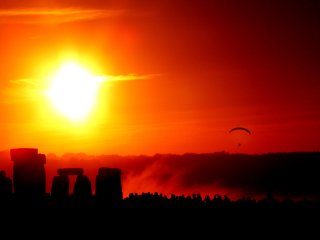By Michael Dorausch, D.C.
The shortest day of the year in the northern hemisphere is upon us as December 21, 2008 marks the winter solstice for those living north of the equator. For many cultures the winter solstice marks the recognition of rebirth. It is a time for festivals, gatherings, and various winter solstice traditions and celebrations across the globe.
 (photo: Winter solstice at Stonehenge – credit: tarotastic)
(photo: Winter solstice at Stonehenge – credit: tarotastic)
The word solstice derives from Latin sol (sun) and sistere (to stand still) and the astronomical event takes place two times each year. This years 2008 winter solstice is on December 21st and the 2009 summer solstice takes place on June 21.
The winter solstice can actually be calculated down to the second and it occurs at the instant when the Suns position in the sky is at its greatest angular distance from the observer. Even though the event is instantaneous, the full 24-hour period is commonly considered the winter solstice. Most in North America recognize the seasonal significance of the longest night as the first day of winter (much of the northern United States has received plenty of snowfall and share of colder weather conditions this month), a time of cold-weather activities like snowman building, skating, skiing, and snowboarding.
From culture to culture, the winter solstice is greatly recognized as a time of rebirth, with rituals, celebrations, festivals, and numerous traditions practiced on the days surrounding the solstice. The Extreme of Winter or Winter Solstice Festival is celebrated by the Chinese, Korean, Vietnamese, Japanese, and other Asian cultures. The origins of the winter festival are traced back to yin and yang philosophy of balance and harmony. With longer daylight hours approaching, an increase in positive energy flows in.
Other festivities, celebrations and events taking place across the globe, during the time of the winter solstice include Hogmanay (New Years Eve celebration) in Scotland, Inti Raymi (Festival of the Sun) in Peru, Junkanoo (masquerade and street festival) in the Bahamas, numerous local festivals throughout the United States, and many others worldwide.
Winter solstice traditions date back for many centuries but those that continue to be popular to this day include spending time with loved ones, feasting, singing, dancing, and going to the chiropractor on Monday (you may have guessed I added that last one).
If you happen to be in the southern hemisphere, happy summer solstice! For those in the northern hemisphere, happy 2008 winter solstice to you!
planetc1.com-news @ 3:03 pm | Article ID: 1229814253




Comments are closed for this article!